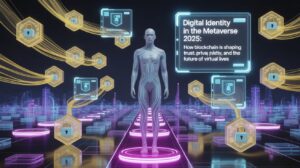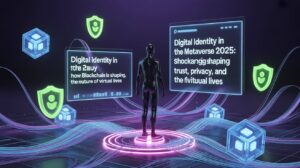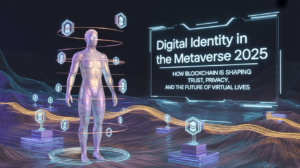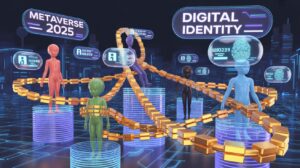🌐 Digital Identity in the Metaverse 2025: How Blockchain Is Shaping Trust, Privacy, and the Future of Virtual Lives

🧠 1. What Is Digital Identity in the Metaverse?
A digital identity is your verified representation in the virtual world — a secure, blockchain-backed version of your real or chosen self.
It can include:
-
Your verified username or avatar
-
Your transaction history and digital assets
-
Certifications, licenses, or professional credentials
-
NFTs representing your achievements or virtual property
In the Metaverse, identity is persistent (it travels with you), verifiable (secured by cryptography), and self-sovereign (you control it — not a tech giant).
It’s not just a profile — it’s your passport to the virtual economy.
🏗️ 2. How Blockchain Powers Digital Identity
Blockchain gives digital identity something traditional systems never could — trust without central authority.
🔹 Key Features:
-
Decentralization: No single company (like Meta or Google) controls your data.
-
Transparency: Your identity credentials are verifiable on public ledgers.
-
Security: Private keys protect your identity from tampering.
-
Portability: One identity works across multiple platforms.
Projects like Polygon ID, Civic, and Soulbound Tokens (SBTs) are pioneering decentralized identity frameworks that merge privacy with accountability.
In 2025, blockchain identity is not science fiction — it’s becoming the standard for digital citizenship.
🧩 3. Why Digital Identity Matters in the Metaverse
Without trusted digital identity, the Metaverse would be chaos — spam bots, fake avatars, scams, and identity theft.
🌍 Real-World Benefits:
-
Verification: Know who you’re interacting with (without revealing personal data).
-
Ownership: Your avatar, wearables, land, or artwork truly belong to you on-chain.
-
Privacy: Selectively disclose information using zero-knowledge proofs (ZKPs).
-
Economic Inclusion: Anyone, anywhere, can prove eligibility for jobs, loans, or membership.
Simply put — no identity, no trust; no trust, no Metaverse.
🕶️ 4. Avatars: The Faces of Our Digital Selves

Your avatar isn’t just a 3D model — it’s your digital body in the Metaverse.
NFT-linked avatars on platforms like Ready Player Me, Decentraland, and The Sandbox store unique traits, clothing, and identity layers that follow you across worlds.
2025 Trends:
-
AI-Generated Avatars that evolve based on user behavior.
-
Emotion Mapping: Avatars replicate facial expressions in real time.
-
Interoperability: One avatar works across multiple virtual universes.
-
Brand Integration: Fashion houses release NFT wearables for avatar customization.
In this new era, identity is not static — it’s dynamic, expressive, and programmable.
🔐 5. Privacy, Data Control & Self-Sovereignty
Today, corporations monetize your clicks and data. In the blockchain-powered Metaverse, you own your data.
💡 Self-Sovereign Identity (SSI)
SSI gives users cryptographic control over their credentials. You can:
-
Prove you’re over 18 without showing your birthday.
-
Prove employment without revealing your salary.
-
Verify nationality without sharing your ID.
Decentralized identity wallets store encrypted proofs — you decide what to share and when.
Privacy isn’t the enemy of transparency — it’s the balance point of freedom.
⚖️ 6. Regulation, Ethics & Digital Rights
As digital identity matures, governments and institutions are catching up.
Global Developments:
-
European Union: Implementing eIDAS 2.0, a blockchain-based EU Digital ID.
-
USA: Testing decentralized ID pilots through the Department of Homeland Security.
-
Asia: South Korea leads with biometric blockchain integration.
Key Challenges:
-
Balancing privacy with law enforcement access.
-
Preventing digital redlining or social-credit scoring.
-
Ensuring inclusivity for those without advanced tech access.
In 2025, legal frameworks are finally recognizing digital identity as a human right.
🏦 7. Digital Identity in Finance & Crypto
Financial access in the Metaverse begins with verified identity.
Banks, DeFi apps, and exchanges now use blockchain credentials for KYC (Know-Your-Customer) and AML (Anti-Money-Laundering) compliance.
Examples:
-
Civic Pass verifies users for DeFi access without storing sensitive data.
-
Polygon ID integrates with NFT marketplaces to prevent fraud.
-
Soulbound Tokens act as reputation scores for borrowers in decentralized lending.
Your wallet address isn’t just numbers — it’s becoming your digital reputation.
🧠 8. The Fusion of AI and Digital Identity

AI personal assistants and avatars are learning to manage your identity autonomously.
Imagine:
-
Your AI agent applying for virtual jobs in the Metaverse.
-
Smart contracts automatically updating your credentials.
-
Voice authentication tied to your blockchain signature.
This combination of AI + decentralized ID forms what experts call “self-governing digital personas.”
It’s a future where your identity works for you — not the other way around.
🏢 9. Corporate & Brand Adoption
Major tech and entertainment companies are integrating blockchain IDs to connect users seamlessly across experiences.
2025 Highlights:
-
Microsoft’s Entra ID integrates wallet-based authentication.
-
Meta collaborates with Polygon ID for cross-platform avatars.
-
Nike and Adidas issue NFT credentials to authenticate virtual apparel ownership.
-
Disney’s Metaverse project uses verified fan tokens for exclusive access.
Brands now compete on trust and transparency, not just visuals.
💬 10. The Role of NFTs in Identity Verification
NFTs aren’t just collectibles — they’re identity certificates.
Examples:
-
Diplomas: Universities issue NFT degrees.
-
Employment: Companies verify staff badges as on-chain NFTs.
-
Memberships: Clubs and DAOs use NFTs as digital passes.
-
Medical Records: Health NFTs store encrypted data accessible only by consent.
Each NFT tells a story about who you are and what you’ve achieved.
🌎 11. Digital Identity & Economic Opportunity
The Metaverse creates a parallel economy worth trillions — but identity is the ticket in.
Opportunities:
-
Jobs: Verified profiles for virtual designers, event hosts, developers.
-
Finance: Crypto loans based on on-chain identity, not credit scores.
-
Commerce: Personalized offers based on blockchain-verified preferences.
-
Education: Blockchain credentials that are globally recognized.
Identity unlocks access — and access builds equality.
⚠️ 12. Risks and Challenges Ahead
Every innovation carries risk.
Potential Threats:
-
Identity Theft: Compromised private keys could expose digital profiles.
-
Centralization Drift: Big players might dominate ID protocols.
-
Interoperability Gaps: Fragmented systems hinder cross-platform mobility.
-
Ethical Concerns: AI-generated avatars may impersonate real users.
Mitigation lies in open standards, strong encryption, and international cooperation.

🔮 13. Future Trends (2026-2030)
-
Universal Digital Passports – a single blockchain identity for all apps.
-
DAO-Governed IDs – user communities managing verification systems.
-
Biometric-Blockchain Fusion – retina and fingerprint tied to private keys.
-
Cross-Reality Continuity – one identity across VR, AR, and real life.
-
Legal Personhood for Avatars – virtual entities gaining rights and liabilities.
By 2030, the line between human and digital identity will blur — yet blockchain will anchor authenticity.
💬 Conclusion: Owning Yourself in the Digital Age
In a world where data is currency and identity is power, blockchain-based digital identity isn’t optional — it’s essential.
The Metaverse will not be defined by graphics or games but by trust, privacy, and freedom of self-expression.
As blockchain, AI, and DeFi converge, we are entering an era where you don’t just use technology — you become part of it.
The future of identity isn’t about escaping reality — it’s about expanding it, securely and authentically.